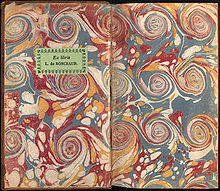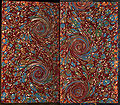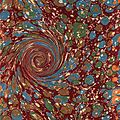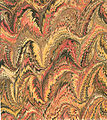Marbled paper

As marbled paper (also: marbled paper, tunk paper , Turkish paper , Venetian paper ; Persian ابر و باد, DMG abr-u bād , 'cloud and wind' or Persian کاغذ ابری, DMG kāġaẕ-e abrī , 'cloudy paper', from which the Turkish ebru ) is the name given to sheets of paper decorated by hand using various special processes , which have increasingly been used since the 18th century , but sometimes also today, as reference material for hand-bound books, as endpaper , for the lining of cases , office containers and furniture were used. Recently, they have been coming back into use as wrapping paper as reprints of originals.
Manufacturing
The production of traditional hand-made marbled paper, which was already known in Japan around the year 1000, is like cutting marble . A shallow basin is filled with the so-called size; This is a jelly made by dissolving tragacanth gum in water, boiling Irish moss (also carrageen moss , Chondrus crispus) or by dissolving methyl cellulose in water (wallpaper paste). The size is removed. Now watercolors with ox bile are applied to the flat surface of the glue bath . This addition serves to reduce the surface tension of the paint so that it can spread over the surface of the size. Due to the consistency of the size, the color cannot mix with it or with the other colors. Therefore, the colors can now be brought into ornamental streak patterns using various techniques, some of which resemble natural marble - hence the name "marble paper". Now a strong sheet of paper, which was previously stained with alum water, is carefully placed on the glue bath and then lifted off again. The color sticks to the paper. The residues of the size are then rinsed off with water. The stain with alum solution ensures that the paint is not rinsed off when the glue residue is rinsed off. The color bonds permanently to the paper when it dries.
In addition to the traditional production with watercolors, oil paints can also be used for marbling. This technique allows marbling in a water bath even without a jelly as a base. However, the results generally lag well behind those of marble paper based on watercolors, as the pattern of the paper cannot be checked as extensively as in traditional production. In particular, papers marbled with oil paints have a specific grainy appearance that does not correspond to the fineness of marbled paper based on watercolor. In this case one also speaks of oil paper.
Although there are very similar marble papers, each paper unlike marble by means of printing techniques such as colored paper produced Brocade , Bronzefirnis- or Model Stationery a unique .
species
Depending on the type of application of the colors (spraying, dabbing, spraying, etc.) and the subsequent mechanical treatment using different tools, usually with sticks or comb- like structures, different ornaments are created. Particularly typical are spotted patterns that come close to real marble ("stone marble paper"), as well as comb-wave-like patterns that arise when you run a comb through the layer of paint ("comb marble paper"). The distance between the individual prongs determines the density of the pattern. Also snail- like twisted variants ("snail marble paper") often occur, which are achieved after pulling the comb with a single stick or with a board with regularly attached sticks; ultimately there are hardly any limits to the imagination .
The custom of drawing pictures of flowers on the glue base comes from Turkey . The term “Ebru” is also used as a specific name for patterns in this technique. The previously common motifs were expanded by the artist Nedim Sönmez and supplemented by visionary landscapes and underwater worlds realized in Ebru technology. The pattern can also be influenced in a specific form by targeted movement of the paper when it is applied to the size. This results in dark stripes that regularly break through the rest of the marble pattern like waves ("wave marble paper").
In Viennese Art Nouveau , the artists Koloman Moser , Josef Hoffmann and Leopold Stolba developed the technique of discovering or hiding figures in the marbling in the sense of blotchography , so that chance and imagination unfold a special game.
Suminagashi
The technique, which originated in Japan, uses ink on water, which is also what defines the meaning of the term. The use of this technique dates back to the 8th century.
Hippie marbling
The term Hippie Marbling was coined in the 1970s and describes the production of large-format marbled fabric panels with the help of paints that mostly float on water and were manipulated with blowguns, among other things.
For several years the technique has also been used with silk webs , for example in Cappadocia .
quality
Marble paper is a particularly high-quality, refined paper: each sheet is unique, as the patterns are not exactly repeated even if the procedure is the same; in addition, there is no exact repetition of the pattern within an arch, as is the case with other ornamentation techniques. Marble paper was formerly manufactured and used as reference material and end paper for books all over Europe, especially in England . Today, marbled papers are produced and sold manually in England, the Netherlands, Germany, France and Italy in particular, but also in America, with the marbling workshops in Venice being the most present in the public eye. In addition to the real marbled paper, there are also inexpensive imitations that reproduce the pattern in ordinary color printing .
Examples
Book bound in marbled paper and parchment waste in Germany around 1811
Marble paper ("stone marble paper") from the cover and endpaper of a book, England around 1830
Marbled front end of a book from the Deutsche Verlags-Anstalt (Stuttgart) around 1900
Marble paper from the cover of a special edition of the Insel-Bücherei , Germany 1921
Web links
- Bedfordshire Record Office of Cockerell marbling: Art of the Marbler. Bedfordshire Archives, 1970, accessed September 21, 2015 (English, production of marbled papers).
- Washington University Libraries collection with many high resolution marbled paper images
- Society of Marbling 2006
- Buntpapier.org
- Information about the Turkish Ebru technique on the University of Guelph website
- The Japanese Suminagashi and other marbleised (English)
- Video: Ebrû - Turkish marbled paper . Institute for Scientific Film (IWF) 1991, made available by the Technical Information Library (TIB), doi : 10.3203 / IWF / C-1767 .
literature
- Anne Chambers: Marbled Paper. A practical guide . Verlag Paul Haupt, Bern et al. 1988, ISBN 3-258-03961-5 .
- Gabriele Grünebaum: colored paper - history, production, use . DuMont Buchverlag, Cologne 1982, ISBN 3-7701-1406-X .
- Gabriele Grünebaum: How to Marbleize Paper. Step-By-Step Instructions for 12 Traditional Patterns . Dover Publications, New York NY 1984, ISBN 0-486-24651-5 .
- Gabriele Grünebaum: Techniques for Marbleizing Paper . Dover Publications, New York NY 1992, ISBN 0-486-27156-0 .
- Josef Halfer: The progress of marble art. A practical handbook for bookbinders and colored paper manufacturers. Self-published, Budapest 1885.
- Marianne Moll: Old and new colored paper . Buntpapierverlag, Hamburg 2011, ISBN 978-3-938423-02-8 .
- Henk Porck et al .: Buntpapier - Einbestungsbuch , Decorated paper - A Guide Book, Sierpapier - Een gids . Buntpapierverlag, Hamburg 2009, ISBN 978-3-938423-17-2 .
- Nedim Sönmez : Ebru. Marbled papers. Maier, Ravensburg 1990. ISBN 3-473-48104-1
- Richard J. Wolfe: Marbled Paper. Its History, Techniques, and Patterns; with special references to the relationship of marbling to bookbinding in Europe and the Western world. University of Pennsylvania Press, Philadelphia 1990.
Individual evidence
- ↑ Michael Pabst, Viennese graphics around 1900 . Munich: Verlag Silke Schreiber 1984, pp. 173-190.
- ↑ Julia Rinck: History of colored paper in excerpts. In: buntpapier.org. Retrieved April 3, 2017 .
- ↑ Hippie Marbling. Film from 1970s, and 2005 interview. blib.tv, accessed on October 25, 2014 (English, 1979s).
- ↑ Hippie Marbling. An art form rooted in the 1960's and a look at one of its eccentric pioneers. April 2005, archived from the original on April 23, 2013 ; accessed on October 25, 2014 (English).


















